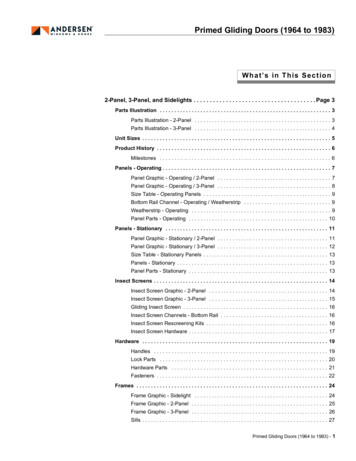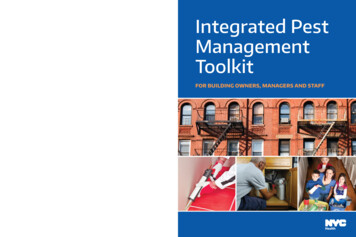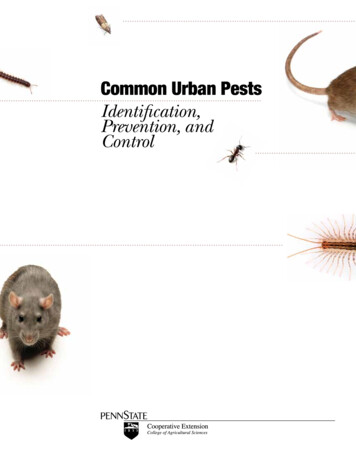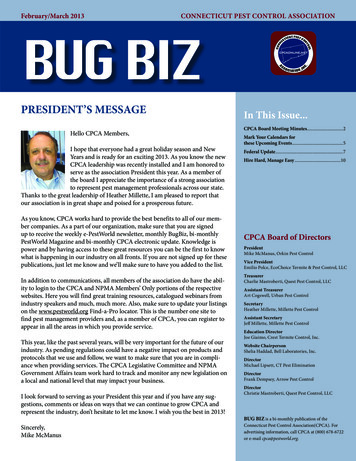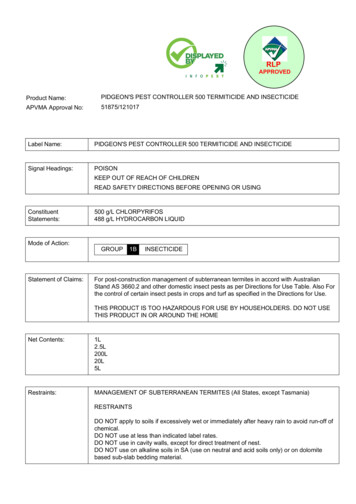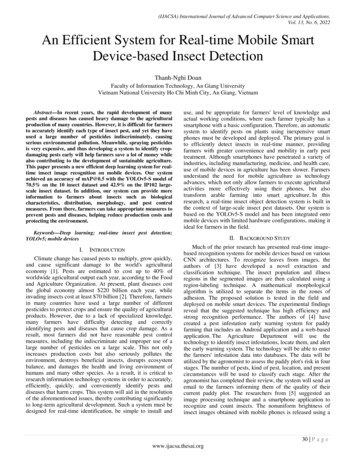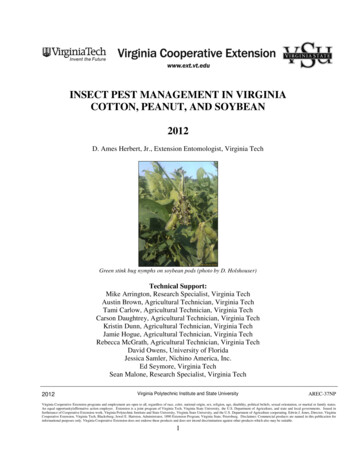
Transcription
INSECT PEST MANAGEMENT IN VIRGINIACOTTON, PEANUT, AND SOYBEAN2012D. Ames Herbert, Jr., Extension Entomologist, Virginia TechGreen stink bug nymphs on soybean pods (photo by D. Holshouser)Technical Support:Mike Arrington, Research Specialist, Virginia TechAustin Brown, Agricultural Technician, Virginia TechTami Carlow, Agricultural Technician, Virginia TechCarson Daughtrey, Agricultural Technician, Virginia TechKristin Dunn, Agricultural Technician, Virginia TechJamie Hogue, Agricultural Technician, Virginia TechRebecca McGrath, Agricultural Technician, Virginia TechDavid Owens, University of FloridaJessica Samler, Nichino America, Inc.Ed Seymore, Virginia TechSean Malone, Research Specialist, Virginia Tech2012Virginia Polytechnic Institute and State UniversityAREC-37NPVirginia Cooperative Extension programs and employment are open to all, regardless of race, color, national origin, sex, religion, age, disability, political beliefs, sexual orientation, or marital or family status.An equal opportunity/affirmative action employer. Extension is a joint program of Virginia Tech, Virginia State University, the U.S. Department of Agriculture, and state and local governments. Issued infurtherance of Cooperative Extension work, Virginia Polytechnic Institute and State University, Virginia State University, and the U.S. Department of Agriculture cooperating. Edwin J. Jones, Director, VirginiaCooperative Extension, Virginia Tech, Blacksburg; Jewel E. Hairston, Administrator, 1890 Extension Program, Virginia State, Petersburg. Disclaimer: Commercial products are named in this publication forinformational purposes only. Virginia Cooperative Extension does not endorse these products and does not intend discrimination against other products which also may be suitable.1
ACKNOWLEDGMENTSThe authors wish to thank the many cooperators and contributors for their help and support inconducting numerous 2012 field tests and demonstrations. Appreciation is extended to AllenHarper, Director, and Bobby Ashburn, Farm Manager of the Tidewater AREC, for their help inimplementing field tests. Thanks to the many other Extension specialists, Agents, producers,state commodity groups, Ag-Industry personnel, and cooperating commercial companies listedbelow.PRODUCERSThanks to the many producers across the region that helped the program by allowing us toconduct field tests and/or sample insects on their farms, or by operating black light traps.Without their cooperation, this program would have less scope and meaning to other farmers.Special thanks to:Clarke Farms, Dinwiddie Co.Bob Martin, Appomattox Co.Drewry Farms, Sussex Co.Vernon Moyer, Goochland Co.Tommy Drake, Southampton Co.Steven and Michael Pittman, Surry Co.Everett Farms, Southampton Co.Mike Grizzard, Southampton Co.Lowe Farms, Surry Co.UNIVERSITY FACULTY AND STAFFVirginia Polytechnic Institute and State UniversityMaria Balota, Crop Physiologist, Tidewater AREC, Suffolk, VAHunter Frame, Field Crops Agronomist, Tidewater AREC, Suffolk, VADavid Holshouser, Soybean Specialist, Tidewater AREC, Suffolk, VAPatrick Phipps, Plant Pathologist, Tidewater AREC, Suffolk, VAThomas Kuhar, Entomologist, Eastern Shore AREC, Painter, VARobert Pitman, Director, Eastern Virginia AREC, Warsaw, VAMary Beahm, Agricultural Specialist, Eastern Virginia AREC, Warsaw, VAPete Schultz, Director/Entomologist, Hampton Roads AREC, Virginia Beach, VAHélène Doughty, Senior Research Specialist, Eastern Shore AREC, Painter, VANorth Carolina State UniversityJack Bacheler, Entomologist, Dept. of Entomology, Raleigh, NCDan Mott, Research Specialist, Dept. of Entomology, Raleigh, NCDominic Reisig, Entomologist, Dept. of Entomology, Plymouth, NCUniversity of DelawareJoanne Whalen, Entomologist, Newark, DEUniversity of MarylandGalen Dively, Entomologist, College Park, MD2
Virginia State UniversityMark Kraemer, Entomologist, Dept. of Entomology, Petersburg, VAVIRGINIA COOPERATIVE EXTENSIONTheresa Long, Accomack Co.Bruce Jones, Appomattox Co.Mike Broaddus, Caroline Co.Watson Lawrence, ChesapeakeMike Parrish, Dinwiddie Co.Keith Balderson, Essex Co.Rachel Grosse, Goochland Co.Brittany Council, Greensville Co.Jim Schroering, Hanover Co.Janet Spencer, Isle of Wight Co.Laura Maxey, King William Co.Lindy Tucker, Lunenburg Co.Haley McCann, Nottoway Co.David Moore, Middlesex Co.John Allison, New Kent Co.William Shockley, Northampton Co.Steve Hopkins, Orange Co.Scott Reiter, Prince George Co.Matt Yancey, Rockingham Co.Robert Clark, Shenandoah Co.Neil Clark, Southampton Co.Chris Drake, Southampton Co.Glenn Slade, Surry Co.Kelvin Wells, Sussex Co.Roy Flanagan, Virginia BeachKeith Starke, Virginia BeachStephanie Romelczyk, Westmoreland Co.UNITED STATES DEPARTMENT OF AGRICULTURERyan Jackson, Research Entomologist, Stoneville, MSCOMMODITY GROUPSCotton IncorporatedCotton FoundationNational Peanut BoardUnited Soybean BoardVirginia Agricultural CouncilVirginia Cotton BoardVirginia Peanut BoardVirginia Soybean BoardVirginia State Cotton Support Committee3
INDEPENDENT CROP CONSULTANTSChad Harrell, Hertford Co., NCStan Winslow, Matt Winslow, and Dale Weeks, Tidewater Agronomics, Inc., Camden, NCCOOPERATING COMPANIESAgri-Technologies, Clinton, NCBayer CropScience, Research Triangle Park, NCBrandt Consolidated, Inc., Springfield, ILCommonwealth Gin, Windsor, VADow AgroSciences, Indianapolis, INE.I. DuPont de Nemours and Company, Wilmington, DEHundley Seed Company, Champlain, VAMonsanto Agricultural Company, St. Louis, MONichino America, Inc., San Antonio, TXSeed Source Genetics, Bishop, TXSyngenta Crop Protection, Inc., Greensboro, NCUnited Phosphorus, Inc., King of Prussia, PAValent U.S.A. Corporation, Walnut Creek, CAWinfield Solutions, LLC, Collierville, TN4
Insect Rating Scales Used in Efficacy Trials and Abbreviations Used in this PublicationThrips injury rating scale for cotton:0 no injury1 10% injured leaves, no bud injury2 25% injured leaves, no bud injury3 75% injured leaves, 0-25% buds injured4 90% injured leaves, 25% buds injured5 dead plantsThrips injury rating scale for peanut:0 no injury1 10% leaves injured2 20% leaves injured3 30% leaves injured4 40% leaves injured5 50% leaves injured 5% terminal buds injured6 50% leaves injured 25% terminal buds injured7 50% leaves injured 50% terminal buds injured8 50% leaves injured 75% terminal buds injured9 50% leaves injured 90% terminal buds injured10 dead plantsAbbreviations used in this publication:1st tl: first true leafai: active ingredientBC: broadcastBMSB: brown marmorated stink bugcotyl: cotyledoncwt: hundred-weightGC: ground-crackingIF: in-furrowRCBD: randomized complete block designTidewater AREC: Tidewater Agricultural Research and Extension Center5
ContentsAcknowledgments.2Insect rating scales used in efficacy trials and abbreviations used in this publication .5Climatological summary of the 2012 growing season .8Table 3. Soil types, nutrient analyses (ppm), and pH for tests conducted in 2012. .12Cotton insect pest management tests and demonstrationsTest: CT12-THP-1, Foliar insecticides for thrips control in cotton .14Test: CT12-THP-2, Orthene 97 various adjuvants for thrips control in cotton .17Test: CT12-THP-4, Regional cotton thrips trial, foliar insecticides .21Test: CT12-THP-5, Insecticide seed treatments for thrips control in cotton .27Test: CT12-THP-6, In-furrow applied insecticides for thrips control in cotton .32Test: CT12-THP-7, Region cotton thrips trial, seed foliar insecticides .35Test: CT12-THP-8, Regional cotton thrips trial, starter seed foliar insecticides,irrigated .41Test: CT12-THP-9, Regional cotton thrips trial, starter seed foliar insecticides, nonirrigated .47Test: CT12-BW-1-Variety, Value of bollworm sprays on double-gene insect-resistantcotton varieties .53Test: CT12-BW-2-Conventional-TAREC, Research to evaluate conventional cottonvarieties and insecticide management of the bollworm/budworm complex .57Test: CT12-BW-4-Foliar, Evaluation of foliar broadcasts for bollworm management incotton .60Test: CT12-BW-Conventional-Everett, On-farm research to evaluate conventional cottonvarieties and insecticide management of the bollworm/budworm complex .63Test: CT12-BW-Conventional-Grizzard, On-farm research to evaluate conventionalcotton varieties and insecticide management of the bollworm/budworm complex .64Test: CT12-BW-Conventional-Clarke, On-farm research to evaluate conventional cottonvarieties and insecticide management of the bollworm/budworm complex .65Test: CT12-BW-Conventional-Lowe, On-farm research to evaluate conventional cottonvarieties and insecticide management of the bollworm/budworm complex .66Test: CT12-SBUG-1, Evaluation of foliar broadcasts for stink bug management in cotton .67Peanut insect pest management tests and demonstrationsTest: PT12-THP-1, Cyazypyr treatments for thrips control in peanut.71Test: PT12-THP-2, Insecticide seed treatments for thrips control in ‘Bailey’ peanut.76Test: PT12-THP-3, In-furrow liquid insecticides for thrips control in peanut .84Test: PT12-THP-4, Orthene 97 various adjuvants for thrips control in peanut .89Test: PT12-THP-5, Different acephate sources for thrips control in peanut .94Test: PT12-THP-6, Insecticide seed treatments for thrips control in ‘Phillips’ peanut .100Test: PT12-THP-8, On-farm evaluation of CruiserMaxx seed treatments for thripsmanagement in peanut .1086
Test: PT12-THP-9, On-farm evaluation of granular in-furrow and CruiserMaxx seedtreatments for thrips management in peanut .109Test: PT12-SCR-1, Belay for rootworm management in peanut .111Test: PT12-SCR-2, On-farm evaluation of insecticides for southern corn rootwormmanagement in peanut .114Test: PT12-CEW-1, Evaluation of foliar insecticides for corn earworm management inpeanut .115Test: PT12-CEW-2, Evaluation of foliar insecticides for corn earworm management inpeanut .117Soybean insect pest management tests and demonstrationsTest: SB12-THP-1, Evaluation of seed treatments on four soybean varieties .120Test: SB12-THP-2, Evaluation of soybean seed treatments .123Test: SB12-THP-3, Evaluation of seed treatments for thrips and bean leaf beetlemanagement in soybean .126Test: SB12-BLB-1, Efficacy of selected insecticides against bean leaf beetle in soybean .129Test: SB12-BMSB-1, Evaluation of foliar broadcast insecticides for brown marmoratedstink bug management in soybean .131Test: SB12-BMSB-3, Evaluation of foliar broadcast insecticides for brown marmoratedstink bug management in soybean .134Test: SB12-BMSB-4, Evaluation of foliar broadcast insecticides for brown marmoratedstink bug management in soybean .137Test: SB12-BMSB-6, Evaluation of foliar broadcast insecticides for brown marmoratedstink bug management in soybean .141Test: SB12-SBUG-1, Evaluation of foliar broadcasts for brown and green stink bugmanagement in soybean .145Table 75. Corn earworm survey of field corn in Virginia, 2012. .148Table 76. Average nightly number of corn earworm moths captured in eastern Virginiablack light traps, 2012 season.1497
Climatological Summary of the 2012 Growing Season—Tidewater AREC, Suffolk, VATable 1. Daily maximum and minimum temperatures ( F) for 2012.JANFEBMARAPRMAYJUNDay of 645.681.157.885.459.157.832.1871.444.8
Table 1, continued. Daily maximum and minimum temperatures ( F) for 2012.JULAUGSEPOCTNOVDECDay of 3.369.587.767.073.849.458.834.682.857.4957.734.2
Table 2. Daily precipitation (inches) for 2012—Tidewater AREC, Suffolk, VA.Day of 000.6703100.01Total1.932.253.47100.084.155.744.80
Table 2, continued. Daily precipitation (inches) for 2012—Tidewater AREC, Suffolk, VA.Day of 0.431.384.14117.1100.833.82
Table 3. Soil types, nutrient analyses (ppm), and pH for tests conducted in 2012—TidewaterAREC, Suffolk, VA.Field #413CropCotton15Cotton 7CottonSoil 82550298220.52.86.2312
2012Cotton Insect PestManagement Tests andDemonstrations13
Test: CT12-THP-1, Foliar insecticides for thrips control in cotton1#1MaterialBrigadier 2SC6.4 ozDates of foliar applications1May 14 and May 212Orthene 974 ozMay 14 and May 213Radiant SC6 ozMay 14 and May 214Athena9 ozMay 14 and May 215Athena11 ozMay 14 and May 216Untreated------Rate/AAll insecticides applied twice (broadcast at first true leaf stage and again in 7 days)Test: CT12-THP-1Experimental design: RCBDYear: 2012Plot size: 4 rows x 35’Crop: CottonVariety: DP 1034 B2RF (insecticideuntreated)Field: 4Row spacing: 36”Planting date: Apr. 30, 2012Harvest date: Oct. 17Row feet harvested: 70Location: Tidewater ARECTreatment application(s):Broadcast using backpackNozzle type: 8002VSNozzle spacing: 18”Field preparation: Rip-strip till on Apr. 2714PSI: 17GPA: 14.3
Test name: CT12-THP-1HerbicidesAdditional insecticidesDate3/30ProductRoundupWeather MaxRate/A22 oz5/02Acumen5/02Date8/09ProductBaythroid XLRate/A3 ozLime & fertilizerDate3/30Product6-18-39Rate/A330 lb1.5 pt6/2524-0-0-330unitsCotoran1 qt6/25Boron1 qt5/02RoundupWeather Max22 oz7/1224-0-0-330units6/01RoundupWeather Max22 oz7/12Boron1 qt6/19RoundupWeather Max22 oz7/06Buccaneer1 qt7/18MSMA1 qt7/18Envoke0.1 oz7/18Cotton Pro1.5 ptGrowth regulatorsDate7/17ProductPentiaRate/A8 oz7/31Pix WSG0.6 oz8/09Pix WSG0.5 ozDefoliation15Date9/27ProductFinishRate/A1 qt9/27Def10 oz9/27Dropp3 oz9/27Super Boll6 oz
Table 4. Thrips injury ratings and yield, CT12-THP-1. Tidewater AREC, Suffolk, VA, 2012. Insecticide treatments werebroadcast on May 14 and again on May 21.Thrips injury rating1May 233.75 aMay 314.38 bJun 44.06 bJun 114.19 bLintlb/acre211184 oz3.06 b3.81 c3.38 d3.00 d1177Radiant SC6 oz3.00 b3.81 c3.75 c3.06 d12664Athena9 oz3.75 a4.38 b3.94 bc4.25 b11355Athena11 oz3.81 a4.25 b4.13 b3.50 c12496Untreated---4.13 a4.75 a4.69 a4.56 a10080.450.300.280.17NS#1MaterialBrigadier 2SCRate/A6.4 oz2Orthene 973LSDMeans within a column followed by the same letter(s) are not significantly different (Protected LSD, P 0.05).1Thrips injury based on a 0-5 scale, 0 no injury and 5 dead plants.2Cotton was harvested on October 17. Gross yields were reduced by 56.4% to account for seed and trash.16
Test: CT12-THP-2, Orthene 97 various adjuvants for thrips control in cotton#1MaterialOrthene 974 oz/A2Orthene 97 InduceOrthene 97 Factor 80LROrthene 97 ResponseOrthene 97 Agri-DexOrthene 97 Dyne-AmicUntreated4 oz/A0.25% v/v4 oz/A1 qt per 100 gal4 oz/A1 qt per 100 gal4 oz/A1% v/v4 oz/A0.625% v/v---345671Dates treated1May 14 and May 21RateMay 14 and May 21May 14 and May 21May 14 and May 21May 14 and May 21May 14 and May 21---All insecticides applied twice (broadcast at first true leaf stage and again in 7 days)Test: CT12-THP-2Experimental design: RCBDYear: 2012Plot size: 4 rows x 35’Crop: CottonVariety: DP 1034 B2RF (insecticideuntreated)Field: 4Row spacing: 36”Planting date: Apr. 30, 2012Harvest date: Oct. 17Row feet harvested: 70Location: Tidewater ARECTreatment application(s):Broadcast using backpackNozzle type: 8002VSNozzle spacing: 18”Field preparation: Rip-strip till on Apr. 2717PSI: 17GPA: 14.3
Test name: CT12-THP-2HerbicidesAdditional insecticidesDate3/30ProductRoundupWeather MaxRate/A22 oz5/02Acumen5/02Date8/09ProductBaythroid XLRate/A3 ozLime & fertilizerDate3/30Product6-18-39Rate/A330 lb1.5 pt6/2524-0-0-330unitsCotoran1 qt6/25Boron1 qt5/02RoundupWeather Max22 oz7/1224-0-0-330units6/01RoundupWeather Max22 oz7/12Boron1 qt6/19RoundupWeather Max22 oz7/06Buccaneer1 qt7/18MSMA1 qt7/18Envoke0.1 oz7/18Cotton Pro1.5 ptGrowth regulatorsDate7/17ProductPentiaRate/A8 oz7/31Pix WSG0.6 oz8/09Pix WSG0.5 ozDefoliation18Date9/27ProductFinishRate/A1 qt9/27Def10 oz9/27Dropp3 oz9/27Super Boll6 oz
Table 5. Thrips injury ratings and yield, CT12-THP-2. Tidewater AREC, Suffolk, VA, 2012. Treatments were applied onMay 14 and May 21.Thrips injury rating1#1MaterialOrthene 97Rate/A4 oz/A2Orthene 97 InduceOrthene 97 Factor 80LROrthene 97 ResponseOrthene 97 Agri-DexOrthene 97 Dyne-AmicUntreated4 oz/A0.25% v/v4 oz/A1 qt per 100 gal4 oz/A1 qt per 100 gal4 oz/A1% v/v4 oz/A0.625% v/v---34567LSDMay 221.75 bMay 292.75 bJun 43.44 bJun 112.94 bLintlb/acre212551.75 b2.50 b3.25 b2.94 b12821.75 b2.56 b3.25 b3.00 b12391.75 b2.69 b3.38 b2.94 b12911.75 b2.50 b3.25 b3.00 b10321.94 b2.44 b3.19 b3.00 b10454.50 a4.56 a4.50 a4.56 a10390.210.360.280.25NSMeans within a column followed by the same letter(s) are not significantly different (Protected LSD, P 0.05).1Thrips injury based on a 0-5 scale, 0 no injury and 5 dead plants.2Cotton was harvested on October 17. Gross yields were reduced by 57.3% to account for seed and trash.19
Table 6. Mean number of thrips per 5 plants, CT12-THP-2. Tidewater AREC, Suffolk, VA, 2012. Treatments were appliedon May 14 and May 21.#1MaterialOrthene 97Rate/A4 oz/A2Orthene 97 InduceOrthene 97 Factor 80LR4 oz/A0.25% v/v4 oz/A1 qt per100 gal4 oz/A1 qt per100 gal4 oz/A1% v/v4 oz/A0.625%v/v---34Orthene 97 Response5Orthene 97 Agri-DexOrthene 97 Dyne-Amic67UntreatedLSDMay 14(cotyledon stage)ImmatureAdult.May 18(early 1st true leaf)ImmatureAdult26.00 b1.00 bMay 22(early 1st true leaf)ImmatureAdult11.25 b0.50 bMay 29(4th true leaf)ImmatureAdult4.50 b2.25Jun 7(4th true leaf)ImmatureAdult11.754.75.20.25 b1.00 b19.75 b0.75 b3.00 b2.2514.003.75.23.50 b2.00 b18.25 b0.50 b3.25 b2.0013.503.75.15.50 b0.50 b15.50 b0.25 b3.00 b2.2513.254.25.21.00 b1.00 b24.25 b0.50 b2.25 b2.5012.003.50.19.00 b0.75 b15.50 b0.00 b3.75 b1.756.752.001.0014.5042.25 a5.25 a141.00 a5.00 a35.25 ans within a column followed by the same letter(s) are not significantly different (Protected LSD, P 0.05).20
Test: CT12-THP-4, Regional cotton thrips trial, foliar insecticidesDates of foliar applications1#1MaterialUntreatedRate/A2Orthene 974.0 ozMay 14 and May 213Benevia 10OD20.6 ozMay 14 and May 214Vydate C-LV17 ozMay 14 and May 215Radiant SC6 ozMay 14 and May 216Karate Z1.28 ozMay 14 and May 217Dimethoate 4EC8 ozMay 14 and May 218Lannate 2.4LV12 ozMay 14 and May 21---1All insecticides applied twice (the first application when the first true leaf bud is evident on90% of the stand and the second application 7 days later)Test: CT12-THP-4Experimental design: RCBDYear: 2012Plot size: 4 rows x 35’Crop: CottonVariety: PHY 375 WRF (insecticideuntreated)Field: 4Row spacing: 36”Planting date: Apr. 30, 2012Harvest date: Oct. 17Row feet harvested: 70Location: Tidewater ARECTreatment application(s):Broadcast using backpackNozzle type: 8002VSNozzle spacing: 18”Field preparation: Rip-strip till on Apr. 27Comments: Cotton seed was treated with base fungicide.21PSI: 17GPA: 14.3
Test name: CT12-THP-4HerbicidesAdditional insecticidesDate3/30ProductRoundupWeather MaxRate/A22 oz5/02Acumen5/02Date8/09ProductBaythroid XLRate/A3 ozLime & fertilizerDate3/30Product6-18-39Rate/A330 lb1.5 pt6/2524-0-0-330unitsCotoran1 qt6/25Boron1 qt5/02RoundupWeather Max22 oz7/1224-0-0-330units6/01RoundupWeather Max22 oz7/12Boron1 qt6/19RoundupWeather Max22 oz7/06Buccaneer1 qt7/18MSMA1 qt7/18Envoke0.1 oz7/18Cotton Pro1.5 ptGrowth regulatorsDate7/17ProductPentiaRate/A8 oz7/31Pix WSG0.6 oz8/09Pix WSG0.5 ozDefoliation22Date9/27ProductFinishRate/A1 qt9/27Def10 oz9/27Dropp3 oz9/27Super Boll6 oz
Table 7. Thrips injury ratings1, CT12-THP-4. Tidewater AREC, Suffolk, VA, 2012. Insecticide treatments were broadcast onMay 14 and again on May 21.#1MaterialUntreated2Orthene 973May 224.50 aMay 294.50 aJun 44.56 aJun 114.50 a4.0 oz3.81 b2.56 d3.38 c3.00 eBenevia 10OD20.6 oz2.81 c2.31 d3.00 d2.56 f4Vydate C-LV17 oz3.69 b3.06 c3.63 bc3.94 c5Radiant SC6 oz3.69 b3.00 c3.44 c3.69 d6Karate Z1.28 oz3.75 b4.31 a4.38 a4.25 b7Dimethoate 4EC8 oz3.63 b3.19 c3.38 c3.94 c8Lannate 2.4LV12 oz3.69 b3.69 b3.88 b4.31 b0.330.310.300.13LSDRate/AMeans within a column followed by the same letter(s) are not significantly different (Protected LSD, P 0.05).1Thrips injury based on a 0-5 scale, 0 no injury and 5 dead plants.23
Table 8. Mean number of thrips per 5 plants, CT12-THP-4. Tidewater AREC, Suffolk, VA, 2012. Insecticide treatmentswere broadcast on May 14 and again on May 21.May 222ImmatureAdult148.25 a3.50 bcMay 293ImmatureAdult36.75 b2.50 cJun 54ImmatureAdult31.00 bc6.25#1MaterialUntreated2Orthene 974.0 oz2.251.50 c19.50 b0.50 c7.25 cd2.25 c18.00 bc6.003Benevia 10OD20.6 oz5.504.50 bc22.75 b7.00 ab1.25 d5.25 bc12.75 c7.754Vydate C-LV17 oz2.752.00 c19.50 b1.00 c7.75 cd7.25 ab32.50 ab7.755Radiant SC6 oz0.253.25 c49.25 b7.25 ab8.50 cd10.00 a51.00 a5.506Karate Z1.28 oz3.009.25 a179.50 a8.25 a64.25 a2.75 c24.75 bc6.507Dimethoate 4EC8 oz0.502.75 c23.00 b1.50 c8.75 cd5.00 bc18.00 bc6.008Lannate 2.4LV12 oz1.001.75 c28.50 b0.75 c17.25 c6.50 a-c50.50 a4.50NS4.3251.874.1614.564.2619.26NSLSDRate/AMay 151ImmatureAdult11.008.50 abMeans within a column followed by the same letter(s) are not significantly different (Protected LSD, P 0.05).1May 15 species composition (based on treatment 1): tobacco thrips—47.1%; western flower thrips—2.9%; eastern flower thrips—2.9%; onion thrips—47.1%;soybean thrips—0%.2May 22 species composition (based on treatment 1): tobacco thrips—50%; western flower thrips—0%; eastern flower thrips—0%; onion thrips—50%; soybeanthrips—0%.3May 29 species composition (based on treatment 1): tobacco thrips—70%; western flower thrips—10%; eastern flower thrips—0%; onion thrips—20%;soybean thrips—0%.4June 5 species composition (based on treatment 1): tobacco thrips—24%; western flower thrips—28%; eastern flower thrips—4%; onion thrips—40%;soybean thrips—4%.24
Table 9. Plant height1, number of true leaves1, number of nodes per plant1, and aboveground biomass2, CT12-THP-4.Tidewater AREC, Suffolk, VA, 2012. Insecticide treatments were broadcast on May 14 and again on May 21.May 15HeightTrue(cm)leaves2.90 a-c0.0May 22HeightTrue(cm)leaves3.980.0May 29HeightTrue(cm)leaves6.400.60 cJun 5HeightTrue(cm)leaves6.43 c1.85 cJun 11Height(cm)10.28Nodes5.80 abBiomass(g)2.86 cd#1MaterialUntreatedRate/A2Orthene 974.0 oz2.63 cd0.04.180.07.230.80 a-c8.05 a3.20 b10.335.00 c3.34 a-c3Benevia 10OD20.6 oz2.98 ab0.04.450.16.931.25 a7.58 ab3.35 ab10.835.10 c3.43 a-c4Vydate C-LV17 oz2.68 cd0.03.800.056.950.55 c7.88 a3.85 a11.055.45 bc4.19 a5Radiant SC6 oz3.00 a0.04.200.07.151.15 ab7.43 ab3.95 a10.205.30 c3.63 a-c6Karate Z1.28 oz2.70 b-d0.04.000.06.530.45 c7.48 ab2.25 c13.705.30 c2.23 d7Dimethoate 4EC8 oz2.55 d0.03.680.06.530.75 bc7.63 ab3.90 a10.035.95 a3.76 ab8Lannate 2.4LV12 oz2.68 cd0.04.130.06.650.60 c6.98 bc3.45 ab9.535.35 bc3.11 b-d0.29NSNSNSNS0.470.770.64NS0.460.88LSDMeans within a column followed by the same letter(s) are not significantly different (Protected LSD, P 0.05).1Based on sampling five plants per plot.2Aboveground biomass based on cutting 5 plants/plot at soil level, pooling those samples into labeled paper bags, and drying at 60 C for 48 hours.25
Table 10. Stand counts and yield, CT12-THP-4. Tidewater AREC, Suffolk, VA, 2012.Insecticide treatments were broadcast on May 14 and again on May 21.Plants/35 row ft1Jun 1191.4Lintlb/acre212584.0 oz93.81451Benevia 10OD20.6 oz94.314144Vydate C-LV17 oz91.414485Radiant SC6 oz95.113216Karate Z1.28 oz97.013397Dimethoate 4EC8 oz87.114738Lannate 2.4LV12 oz88.61457NSNS#1MaterialUntreated2Orthene 973Rate/ALSDMeans within a column followed by the same letter(s) are not significantly different (Protected LSD, P 0.05).1Based on sampling all plants in rows 1 and 2 of each plot.2Cotton was harvested on October 17. Gross yields were reduced by 58.8 % to account for seed and trash.26
Test: CT12-THP-5, Insecticide seed treatments for thrips control in cottonMaterial1#1Untreated---2Gaucho 600FS9.49 oz/CWT38Gaucho 600FS Poncho VotivoAeris Seed Applied System Poncho VotivoAeris Seed Applied System Poncho VotivoAeris Seed Applied System Poncho Votivo USF0738Avicta Complete Pak—AvictaAvicta Complete Pak—CruiserTemik 15G (IF)9.49 oz/CWT10.76 oz/CWT18.98 oz/CWT10.76 oz/CWT12.66 oz/CWT10.76 oz/CWT12.66 oz/CWT10.76 oz/CWT6.074 oz/CWT0.15 mg ai/seed0.375 mg ai/seed5 lb/A9Aeris Seed Applied System18.98 oz/CWT4567Rate/AGaucho 600FS9.49 oz/CWT Poncho Votivo10.76 oz/CWT USF07386.074 oz/CWT1All treatments contain Vortex FL @ 0.08555 oz/CWT, Baytan 30 @ 0.4823 oz/CWT,Allegiance FL @ 0.7524 oz/CWT, Pro-ized Blue Colorant @ 1.04 oz/CWT, Calcium Carbonate@ 6 oz/CWT, Color Coat White @ 1 oz/CWT, Secure Plus Se
1 INSECT PEST MANAGEMENT IN VIRGINIA COTTON, PEANUT, AND SOYBEAN 2012 D. Ames Herbert, Jr., Extension Entomologist, Virginia Tech Green stink bug nymphs on soybean pods (photo by D. Holshouser)
